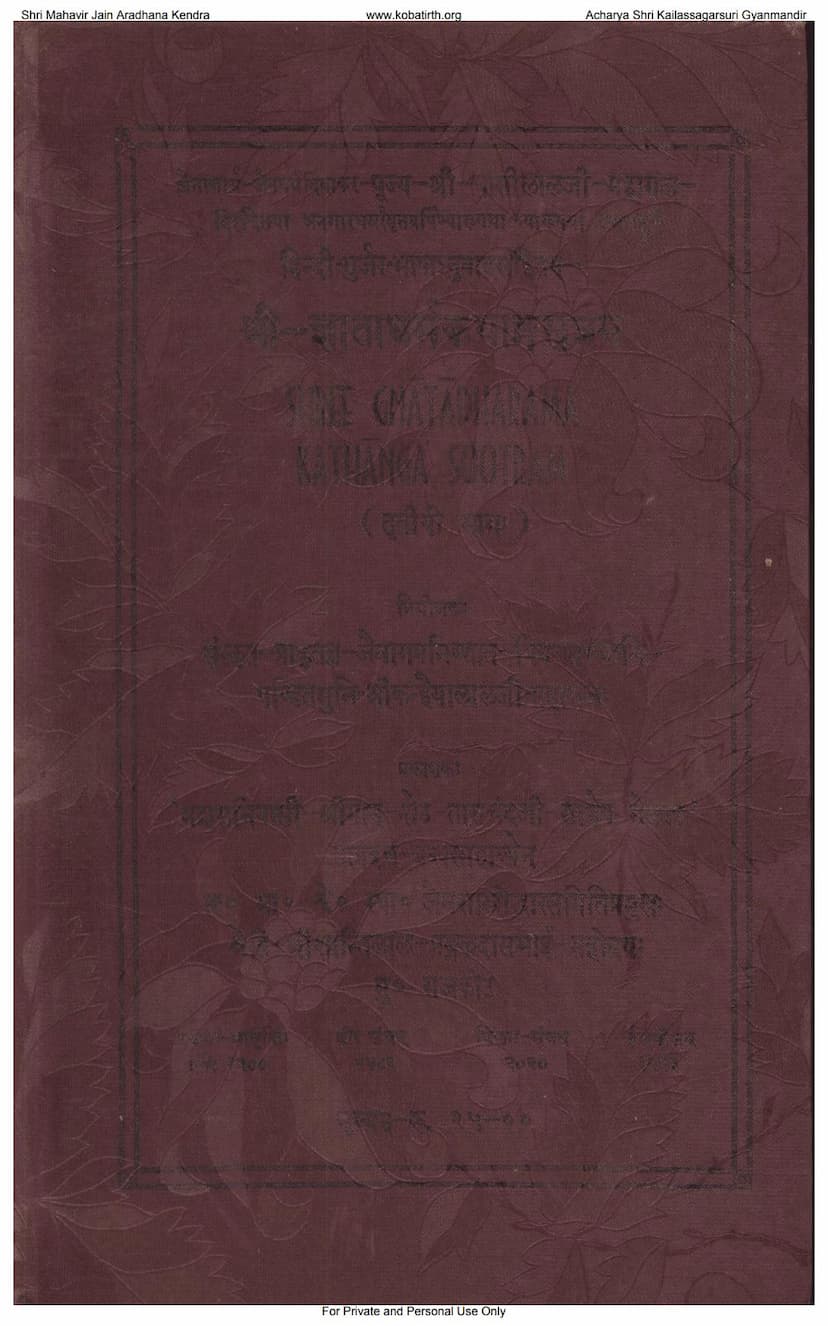Gnatadharmkathanga Sutram Part 03
Added to library: September 1, 2025

Summary
This is a comprehensive summary of the provided Jain text, focusing on the key elements and narratives within the Gnatadharmkathanga Sutram Part 03.
Book Title: Gnatadharmkathanga Sutram Part 03 Author: Kanahaiyalalji Maharaj Publisher: A B Shwetambar Sthanakwasi Jain Shastroddhar Samiti Catalog Link: https://jainqq.org/explore/020354/1
This volume of the Gnatadharmkathanga Sutram, a significant Jain text, is presented with commentary by Acharya Shri Ghasi Lalji Maharaj and translated and edited by Pandit Muni Shri Kanahaiyalalji Maharaj. This third part covers chapters fourteen through twenty-nine, and the second Shruta Skandha, detailing various ethical narratives and philosophical principles.
Key Narratives and Themes:
The text is rich with stories that illustrate Jain principles of conduct, karma, and spiritual progress. The main narratives covered in these chapters include:
-
Chapter 14 (Tetliputra Pradhan Charitra): This chapter introduces the story of Tetliputra, an astute minister skilled in statecraft. It also details the captivating beauty of a maiden named Pohila, daughter of Kalad, a goldsmith. The story likely unfolds through their interaction and its consequences, possibly illustrating themes of attraction, societal roles, or karmic consequences.
-
Chapter 15 (Nandiphala Swarup Nirupan): This chapter is titled "The Nature of Nandiphala." The narrative begins with a wealthy merchant named Dhanya in Champanagari. Dhanya decides to travel to Ahichhatra for trade. He makes extensive arrangements for his journey, including gathering goods and preparing carts. He issues a proclamation through his servants to the populace, warning them about the dangerous Nandiphala trees. The proclamation highlights that consuming Nandiphala fruits or resting under their shade leads to untimely death, while other trees are safe. This story likely illustrates the importance of heeding wise counsel, understanding the consequences of actions, and the concept of karma through the fates of those who ignore the warning and those who heed it.
-
Chapter 16 (Sukumarika Charitra and Draupadi Charitra - Initial Stages): This section of the text introduces the story of Sukumari, a beautiful and accomplished maiden, and begins to lay the groundwork for the narrative of Draupadi. It touches upon the societal norms and the lives of prominent figures like King Kankara and his minister Tetliputra, setting the stage for more complex events. The narrative highlights the meticulous care taken in Sukumari's upbringing and the unfortunate fate of her mother, Bhadra, who gives birth to a stillborn child. The subsequent exchange of babies between Pohila (who is suggested to be associated with Tetliputra) and the royal couple introduces themes of deception, fate, and the karmic consequences of actions. The chapter also introduces the characters of King Kankara, Queen Padmavati, and their ministers, as well as the maidens Kali, Ratri, and Ruchira, further enriching the narrative tapestry with characters and their potential interactions.
-
Chapter 17 (Draupadi's Invitation to Kṛṣṇa): This chapter continues the narrative, focusing on the events leading up to the marriage of Draupadi. King Drupad, after the unfortunate demise of his minister, Teṭaliputra, contemplates the future of his state and the well-being of his people. He decides to consult with Acharya Kankalnarad, a sage known for his wisdom and clairvoyance. The chapter details the elaborate preparations made by King Drupad for the grand event, including the construction of a magnificent pavilion and the meticulous arrangements for the guests. King Drupad sends messengers to various prominent rulers, including Krishna Vasudev, the Pandavas, and other kings, inviting them to the Svayamvara. The narrative emphasizes the importance of respecting guests and ensuring their comfort, as highlighted by Krishna Vasudev's own meticulous preparations and gracious hospitality. The story also touches upon the complexities of fate and destiny, as the king grapples with his past actions and their karmic repercussions.
-
Chapters 18-29: These chapters are mentioned in the table of contents and indicate further narratives that likely delve into various characters' lives, ethical dilemmas, and the unfolding of karmic destinies. The themes explored in these chapters are likely to include:
- The stories of various women: Chapters like those describing Rajdarika, Dharmaruchi, Shumbhanishumbha, Rupadi, Kamaladi, and Chandrapraadi deities suggest a focus on female characters, their virtues, trials, and spiritual journeys.
- Economic and societal aspects: The mention of trade, navigation (boat merchants), and the description of islands (Kalyan Island) hints at narratives that might explore economic activities, societal structures, and the impact of geographical locations on human lives.
- Philosophical and ethical discussions: Themes like the nature of dharma, the consequences of actions (karma), the path to liberation, and the importance of right conduct are likely to be woven into these stories.
Overall Purpose and Significance:
This volume of the Gnatadharmkathanga Sutram serves as a didactic text, using stories and dialogues to impart Jain philosophical and ethical teachings. The narratives are designed to illustrate the principles of:
- Karma: The consequences of actions, both positive and negative, are a central theme.
- Dharma: The importance of right conduct, righteousness, and spiritual discipline.
- Non-violence (Ahimsa): The text likely emphasizes the Jain principle of non-violence towards all living beings.
- Renunciation: The stories might depict characters who renounce worldly attachments for spiritual pursuits.
- Detachment and Self-control: The narratives likely showcase individuals who practice detachment from worldly pleasures and control their senses.
The detailed commentary and translation by esteemed scholars aim to make these profound teachings accessible to a wider audience for private and personal use, fostering spiritual understanding and ethical reflection within the Jain tradition.